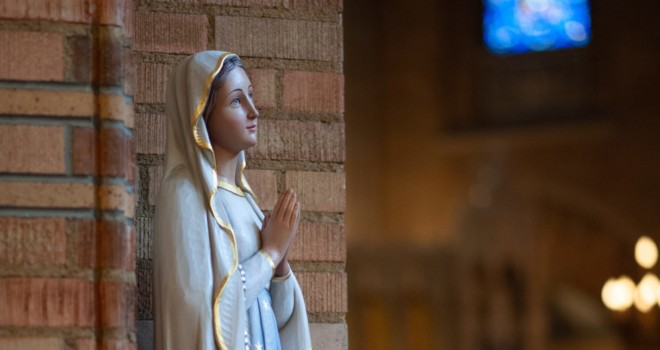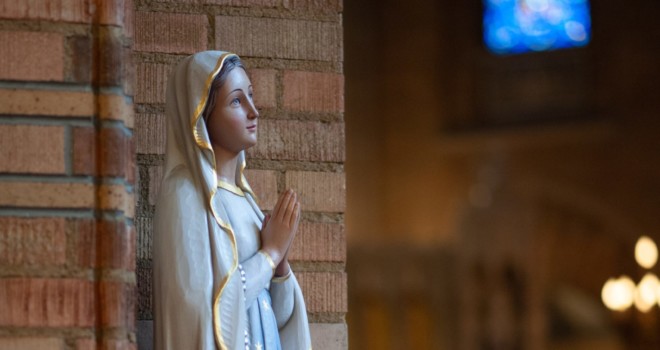Often in life it’s best to start with the end-goal and work backwards. For example, consider a 10-year-old who is a prodigy in playing the violin and hopes someday to play for a world-class orchestra like the Vienna Philharmonic.
Their end-goal or the what of their life has been clearly defined and now the specifics of how to get there must be identified. This will involve long hours of practice, getting an excellent teacher, and probably studying at an elite institution like The Julliard School.
The practicing Catholic starts with the end-goal of heaven and more specifically the Beatific Vision, and, in working backwards, knows they must die in a state of grace in order to enjoy the blessings of both. We want to enjoy the Beatific Vision, but, in working backwards, need to be reminded that, for most earnest Catholics, Purgatory precedes it.
Instead of taking our venial sins lightly in this life and trusting that they will be purged in the next life, why not have a Purgatory Now mentality that, by the grace of God, seeks to aggressively eradicate venial sin in the here and now? The strategy is to suffer on the front-end in order to diminish, or even in some rare cases eliminate, suffering on the back-end of the hereafter.
Such a strategy in time will lead us to agree with French Catholic novelist Leon Bloy who said: “The only real sadness, the only real failure, the only great tragedy in life, is not to become a saint.”
Christ promised us in the Sermon on the Mount, “Blessed are the pure in heart, for they shall see God” (Mt. 5:8). This has ramifications for this life and the life to come.
As creatures conceived in iniquity (Ps. 51:5), we are born with impaired vision, but, as we grow in sanctity, our vision becomes clearer and we’re able to see God with the eyes of faith. This may mean, among other things, seeing God at work in someone’s life when no one else can, enjoying the presence of God as we spend an hour before the Blessed Sacrament, and/or sensing heaven intersecting with earth during Mass.
Sometimes in our earthly pilgrimage, our priorities become inverted and we grow confused amidst a cacophony of voices. Looking at heaven through Scripture, Tradition, the lives of the saints, etc. can help us define our priorities and clarify our vision: if it’s going on heaven, it’s important enough for us to try to imitate it here on earth.
Christ himself said: “…on earth as it is in heaven.” For example, the divine liturgy that we see in heaven in Revelation 4 and 5 points to what we should be trying to do, albeit imperfectly, in the Holy Sacrifice of the Mass here on earth.
The biblical witness is ample in declaring the reality of the Beatific Vision on the other side of eternity:
“For now [on earth] we see in a mirror dimly, but then [in heaven] face to face” (I Cor. 13:12).
“Beloved, we are God’s children now; it does not yet appear what we shall be, but we know that when he appears we shall be like him, for we shall see him as he is” (I Jn. 3:2).
We lean into the Beatific Vision now as much as we can by practicing a lifestyle of beholding Christ during our brief time on earth which passes like a shadow (Ps. 144:4). Our Lady can lead the way: Christ was/is both her Son and her Lord. Was there any greater delight for her during her time on earth than to behold His Person, virtue, and attributes for 33 years? He truly was the apple of her eye.
There was no greater desolation for her than when He breathed his last on the cross and His body was taken away. He was no longer there to behold.
The unity that she had experienced with him in mind, will, emotions, spirit, etc. was temporarily severed. She could’ve very well cried out, “My God, my God, why have you forsaken me?” There was no greater consolation for her than when she was assumed. She would be reunited with her Son and Lord and get to behold his majesty in the Beatific Vision throughout eternity.
French tradition has it that Mary Magdalene, after a fruitful evangelistic ministry in Marseilles with Lazarus and some companions, spent the last thirty years of her life in a cave. If true, she was no doubt returning to the lifestyle of contemplation, of beholding and adoring her Lord, that she had practiced during his time on earth and especially at the foot of the cross.
I’d be remiss to not mention the role humility plays in cultivating a lifestyle of beholding Christ. The prophet Isaiah tells us who God chooses to dwell with: “I dwell in the high and holy place, and also with him who is of a contrite and humble spirit, to revive the spirit of the humble, and to revive the heart of the contrite” (57:15).
It’s no coincidence that arguably the greatest person of the Old Testament, Moses, was also the most humble (Num. 12:3) and had a unique relationship with God in speaking to him face-to-face (Ex. 33:11). As the pinnacle of all creation, Mary is perfectly humble and without sin and has a face-to-face intimacy with her Son, both while on earth and in heaven, only surpassed by the Father and the Spirit.
The practicing Catholic may rightly wonder what a lifestyle of beholding Christ would look like in their daily lives. It means taking the material we’re given in our workaday, quotidian existence and converting it into a meditation of Him. It means being “detectives of transcendence” who are open to beholding the face of Christ as we navigate a difficult existence. As we behold him, our lives are gradually transformed into his likeness:
“And we all, with unveiled face, beholding the glory of the Lord, are being changed into his likeness from one degree of glory to another; for this comes from the Lord who is the Spirit” (II Cor. 3:18).
This transformation rarely happens in an ambiguous, ethereal manner. Money is tight and we’re tempted to give less to our local parish and charitable organizations. However, in the daily readings, Christ talks about the widow’s mite, we behold Him in His lavish generosity, and decide to continue to give our usual amount.
We hesitate to talk to a co-worker about Christ though we sense that they are ripe for the gospel. During that month, we read about the missionary exploits of St. Francis Xavier, behold Christ the Evangelist (Eph. 4:11), and decide to broach the topic with our co-worker at the opportune time.
We can see the face of Christ and behold him in many of the people we meet along the way. For example, Christ told St. Faustina that humble and meek souls and the souls of small children most resemble Him. He also told us that when we served “the least of these my brethren”, we actually served Him (Mt. 25:31-46).
With the eyes of faith, we behold the face of Christ and want to become more humble, meek, and childlike in admitting that “apart from [him] we can do nothing” (Jn. 15:5). In seeing the face of Christ in the least of these my brethren, we’re motivated to perform corporal works of mercy in feeding the hungry, sheltering the homeless, visiting the sick, etc.
As we grow in grace, like Our Lady, our greatest delight becomes beholding Christ. This prepares us for the Beatific Vision, where “no eye has seen, nor ear heard, nor the heart of man conceived, what God has prepared for those who love him” (I Cor. 2:9).












